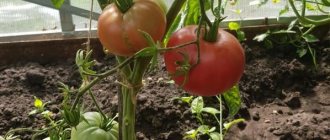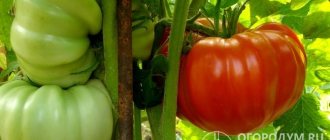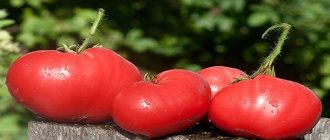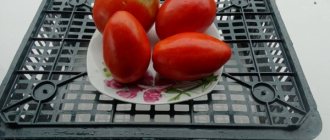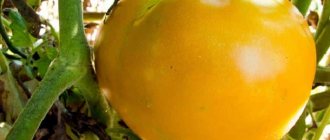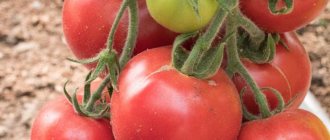In rain, heat, and bad weather, farming enthusiasts always work on their plots. To help them, breeders developed a stable and hardy Pink Whale tomato. It has huge giant fruits, wonderful taste and commercial qualities. The variety is also characterized by good productivity.
| Height | Landing location | Ripening time | Fruit color | Fruit size | Origin | Fruit shape |
| Tall | Greenhouse, Open ground | Mid-season | Pink | Large | Variety | Flat-round |
Description of the tomato variety Pink Whale with photo
The mid-season tomato variety “Pink Whale” has bushes that are not very spreading, tall, from one and a half to two meters, which require mandatory formation, pinching and tying. The stems of the plant are tender and brittle and require careful handling. The variety is indeterminate and requires pinching off the tops after the formation of several clusters with ovaries. The first inflorescence appears above the 7-8 leaves, and the subsequent ones appear after each pair of leaves. The best way to grow the “Pink Whale” is to form a bush with one or two stems, so all other side shoots must be pinched.
Full ripening of tomatoes when grown in the southern regions occurs on the hundredth day after germination, in the middle zone - on the 120th day.
Comment! If the bushes grow in open ground, then at the flowering stage they need shelter from morning frosts.
Gardeners receive about 13 kg of ripened fruits per square meter of plantings
Description of fruits
Pink Whale tomatoes are heart-shaped and large in size. The weight of one fruit is 0.5 kg or more. The pulp of tomatoes is fleshy, practically without seeds, and has a delicate sweet taste and aroma. The color of the fruit is pink, the peel is thin.
Comment! Tomatoes have few seeds, so collecting planting material from them is very problematic.
Growing rules
Chinese pink tomato seeds
Preparing seeds and soil
For high fruiting, it is better to grow the seeds yourself, then you can be sure that the seedlings will not produce empty shoots and empty flowers. Seeds are sown in late February and early March.
Before sowing, the following manipulations are carried out:
- The planting material is kept in potassium permanganate for half an hour for disinfection. Then the seeds are dried, this will give them a free-flowing consistency;
- The raw materials are planted in a box with soil. By this time, the soil should be fertilized with peat and moderately watered with warm water;
- Shallow holes are made into which one seed is dropped;
Important! You cannot cover the box with a lid or other material; only cling film or glass is allowed to allow light to pass through.
- The film or glass is removed weekly to saturate the soil with oxygen and spray the seeds with water;
- When the first shoots hatch, the glass is completely removed.
Planting seedlings in open ground
Now the soil in the garden is being prepared. The soil is fed with mineral and organic means. Chicken manure or cow manure can be used as fertilizer. A solution is prepared in the following proportions: 1 kilogram of fertilizer per five liters of water. Everything is thoroughly mixed and evenly distributed under each bush. Also, as a preventive measure against diseases and parasites, you should treat the soil with copper sulfate (a three percent solution is enough).
Plant the seedlings in furrows 3 to 4 cm deep. At night, the bushes should be covered until the weather stabilizes and becomes warm.
Chinese pink tomato
For 1 sq. a meter goes a maximum of two seedlings. The bushes grow large and the foliage is plentiful, so if you do not keep the distance, you can harm them.
Watering
The irrigation procedure requires a responsible approach. Tomatoes grow best in dry soil. Frequent watering will lead to an excess of moisture, the root system will begin to disappear, and the fruits will become watery and soft. The taste will also be distorted, pink tomatoes will become acidic.
Top dressing
High-quality fertilizers promote growth and fruiting. The first feeding is carried out 14 days after planting, then several more times throughout the summer season.
The following solutions are widely used as food:
- 25 grams of superphosphate and 1 kilogram of mullein;
- 10 liters of water, five grams of potassium sulfate and 50 grams of nitroammophoska.
If the seedlings are weak and do not take root well, the amount of fertilizing can be increased. However, as soon as the bushes begin to abundantly gain leaf mass, it is impossible to fertilize, otherwise all the energy will be spent on the growth of the stem, and not the vegetables.
Chinese pink tomato in the garden
Picking
To obtain a large fruit, picking is carried out in a timely manner. Closer to the top, part of the ovaries is cut off. There should be no more than five ovaries on one branch. Tomatoes will gain juiciness and weight from 800 grams.
Characteristics of the Pink Whale tomato
The main characteristic qualities of the Pink Whale tomato are their large size and pleasant, juicy, sweet, with barely noticeable sourness, taste, as well as high yield. The fruits themselves have a fleshy pink flesh and practically no seeds inside. Excellent for preparing salads and eating fresh.
The growing season of the crop lasts from 100 to 120 days, so the variety is considered mid-season. When grown in greenhouse conditions, the ripening process of tomatoes occurs a couple of weeks faster than in open ground. Experienced gardeners harvest the first harvest at the end of June.
Growing a Pink Whale tomato is not too labor-intensive, but during care you must follow certain rules. The variety has good resistance to some diseases, is moderately resistant to lack of watering and changes in weather conditions, but may suffer from prolonged stagnation of moisture in the ground, which blocks the access of oxygen to the roots of the plant. Tolerates unfavorable growing conditions well.
Gardeners receive about 13 kg of ripened fruits per square meter of plantings
Productivity and fruiting
Typically, the growing season from the emergence of seedlings to technical ripeness takes 115 days. It is better to start harvesting when it is fully ripe, which is judged by its rich pink color (late July - April). Each cluster of “Pink Whale” bears from 4 to 9 large fruits; you can get up to 15 kg of tomatoes per square meter. The quality and quantity of the harvest is highly dependent on care and sunlight.
Attention! Bushes require timely organization of support, otherwise the stems may break under the weight of the fruit.
Area of application of fruits
“Pink whale” is a salad-type tomato, mainly consumed fresh. Also used for making dressing sauces, ketchups and healthy juices. Due to the presence of important nutritional components and sweet taste, tomatoes are often used for preparing children's and dietary dishes. The only caveat concerns their large size, which is why they are not suitable for preservation in their entirety.
Eating Pink Whale tomato helps strengthen the immune system, activate blood circulation and improve the functioning of the cardiovascular system.
Resistance to diseases and pests
“Pink whale” has good immunity to fungal, viral and bacterial diseases. It is resistant to diseases such as:
- Alternaria blight;
- fusarium;
- verticillium wilt.
As for insects, the following are dangerous for young bushes:
- mole cricket;
- tomato cutworm caterpillars;
- aphid.
Description and characteristics of the variety
There are many types of tomato on the market with the same name from various collectors and agricultural companies. The originator declares the tomato to be semi-determinate in height - from 1 to 1.5 m. But there are also subspecies that reach two meters, and a number of collectors offer the Pink Flamingo determinate tomato - up to 60 cm.
In terms of timing, it is classified as early rather than mid-season - 110-115 days pass from seed germination to harvest. In warm climates or in greenhouses, fruits can be harvested already on the 95th day. Usually the variety has medium-sized, 100-200 g, elongated plum-shaped tomatoes with a spout, but breeder Valentina Redko offers large, up to 800 g, heart-shaped tomatoes under this name. They are bright crimson in color with thin red stripes and have 4-6 chambers with seeds inside. The pulp is juicy, sweet and aromatic, with excellent taste.
They can be used for preservation and pickling, inclusion in various dishes and fresh consumption. Tomatoes make delicious juice and tomato pastes.
Advantages and disadvantages
“Pink whale” are very sweet, fleshy tomatoes, suitable for growing both in greenhouses and in open ground. Despite their capriciousness, vegetable growers very often choose them for growing.
Can be picked unripe and brought to ripeness in a dark, warm place
pros
- high productivity;
- a small amount of liquid and seeds in the fruits;
- universal use;
- excellent taste;
- good transportability;
- low level of acidity;
- relative early maturity.
Minuses
- the need for the formation of bushes;
- demands for regular garter;
- susceptibility to late blight infection;
- requirement for frequent watering;
- fear of morning dew and frost;
- the need for shelter in autumn and spring.
Growing rules
Tomatoes require normal care and are propagated from seedlings. This is not a hybrid species, but an independent variety, so you can collect the seeds from tomatoes grown yourself or purchase them in a retail chain.
Planting seedlings
It is recommended to sow “Rosy Cheeks” tomato seeds for seedlings in the first half of March. Algorithm of actions:
- Prepare the soil (can be purchased at a specialty store): equal parts peat, humus or turf soil. Treat with a 5% solution of potassium permanganate.
- The container (container, peat or plastic cups) is filled with prepared soil.
- Tomato seeds are treated with manganese and placed in a growth-stimulating drug for 5 hours.
- Lay it to a depth of 1-2 cm, water it, and cover it with film on top.
The seedlings are placed in a warm place, protected from direct sunlight. After germination, the film is removed. When 3 leaves appear, they dive. The young tomato shoots remain in this state for 2 months. The seedlings are watered once a week and complex fertilizers are applied.
Tomato transplant
Tomato planting material is planted in a greenhouse for a permanent place of growth in early May, in open ground after the soil has warmed up to at least +13 C. The soil is first loosened, weeds are removed, and organic fertilizers are applied. Place tomatoes in 3 pieces. per 1 m3, maintaining a distance of 0.5 m between bushes and the same row spacing.
Subsequent care for tomatoes
After placing the “Rosy Cheeks” tomato variety, two feedings are carried out. The first is with phosphorus-containing agents before flowering, the second 2 weeks after fruit set. Recommendations for caring for tomatoes:
- Water as the soil dries out.
- All the stepchildren clean up.
- The bush is formed with a strong lateral shoot; you get two trunks: the main one is short, the auxiliary one is twice as long.
- As the growing season progresses, constant tying to the support is carried out.
In an open area, the soil is mulched with peat or straw; in a greenhouse this does not need to be done. Prevention of fungi and parasites is carried out.
Features of cultivation
To achieve a high yield, it is important to plant Pink Whale tomatoes correctly and take proper care of them:
- When growing seedlings from seeds, fertile, loose soil should be used, and the procedure itself should be performed in early March. Then, by the time of transplantation, the young plants will have time to become well established.
- When planting seedlings in the ground, even in greenhouse conditions, keep them under cover for at least two days.
- During planting, do not deepen the root system, since it must pass through the top layer of soil; maintain a density of no more than three seedlings per 1 sq.m.
- During subsequent care, water the plants generously with warm water at the roots (at least once every 5 days).
- To prevent the soil from drying out, use mulch.
- Make sure that stepsons do not appear on the bushes. After the 15th leaf has grown, pinch the stems.
- Carefully tie up the trunks and bunches of tomatoes.
- Cut off the lower leaves of the crop and do not allow them to come into contact with the ground.
- Loosen the soil to ensure its breathability.
- With the arrival of autumn, cover bushes growing in open ground.
Comment! Tomato seedlings of this variety are planted in a permanent place at the age of two months (late May - early June).
“Pink whale” requires regular moistening; the soil should not be dry for more than two days
Caring for pink tomatoes
According to reviews from experienced vegetable growers, pink varieties of tomatoes are a little more troublesome to grow than red ones; they require more attention. They do not tolerate drought well and, unlike red tomatoes, are more likely to suffer from late blight. To protect them from diseases, before planting seedlings in the soil, you need to treat it with the following composition: dilute 4 tablespoons of dry mustard in 100 grams of warm water, add sodium carbonate - 2 teaspoons, ammonia - 1 teaspoon, copper sulfate – 100 grams (pre-dilute it in 1 liter of water). Bring the volume to the size of a ten-liter bucket, stir well and treat the soil (this is enough for ten square meters).
Tomatoes will respond to this care with a large harvest.
Pest and disease control
Since the “Pink Whale” is not resistant to late blight, preventive measures should be taken when caring for the plant. Irrigation of bushes with 1% Fitosporin and Bordeaux mixture is best suited for this.
A day before planting, the tomato beds should be sprayed with a mixture of sodium carbonate, ammonia, laundry soap and copper sulfate, in a ratio of 2 tsp, 1 tsp, 20 and 50 g (dilute the components in a bucket of water).
Important! To avoid the development of diseases, the soil must be treated before planting seedlings.
To help control pests, gardeners most often use drugs such as:
- Operacat.
- Decis.
- Aktofit.
Pros and cons of the variety
With all its characteristics, each variety has both pros and cons. Reviews indicate the main points, you can build on them when choosing.
The advantages of this tomato variety include:
- taste qualities;
- a small amount of seeds and liquid in the fruit;
- high productivity;
- the ability to use both for salads and for preparations;
- relative early ripeness;
- low acidity, and this allows it to be consumed by people with diseases of the gastrointestinal tract.
Disadvantages according to reviews from gardeners:
- the stem is weak, and therefore the plant, like the clusters of fruits, will have to be constantly tied up;
- it is necessary to form a bush, leaving 2 stems, otherwise the yield will decrease significantly;
- the variety is moisture-loving and requires watering as soon as the soil dries out;
- easily infected with late blight, so you should not plant the Pink Whale tomato in a place where other varieties grew before, or the soil must first be treated with a special solution;
- It is afraid of even slight frosts and autumn morning dew, and if planted in open ground, it requires shelter.
There are also positive reviews about the Pink Whale tomato from agrotechnical complexes, and to the characteristics you can add such advantages as: transportability, the ability to remove unripe fruits, and bring them to technical ripeness in a warm, dark place.
Important! In order to avoid diseases, be sure to treat the soil before planting.
Recipe. For 10 m2 it is necessary to dilute in 10 liters of water: 2 teaspoons of sodium carbonate, 1 teaspoon of ammonia, 1/10 of a piece of laundry soap, 50 g of copper sulfate. Spray the soil a day before planting.
Reviews
I can’t call the “Pink Accordion” variety problematic. Perhaps for beginners it will seem too difficult to care for, but for people who grow in greenhouses, it won’t even bother. The variety is quite productive and tasty. Every year we close the salads and use only this. This year I want to try making tomato juice.
There is very little information about the diseases. I can say that if you take care of the plant, fertilize it and water it, then no diseases will take root. By the way, a lot of fakes have appeared, so buy only from trusted sellers.
At first it was very difficult to figure out how to attach the stems and brushes to the support. I decided to simplify my task. I pulled the wire at 50 cm, 100 cm, 130 cm and 150 cm. They are formed into 2 and sometimes 3 stems. It is very convenient and beautiful, it seems as if they are growing like a “wall”. There were no problems. The harvest is good and large. I didn’t regret taking this variety. Although I took it for the first time, I got poor quality seeds.
source
Forming the stems
For better yield, seedlings should be placed in a checkerboard pattern. This arrangement allows you to be completely saturated with useful microelements.
Do not forget that the shoots of the “Accordion” grow throughout the entire growth and fruiting period. Accordingly, you can’t abandon pinching, otherwise you will lose the entire harvest due to late blight.
Pay attention to the formation of the tomato bush. It must be formed following certain rules.
First, before performing work, you need to make a weak solution of potassium permanganate. Hands must be gloved.
The second, important rule is that you need to trim the shoot only when it has reached 5 centimeters. If its length is shorter or longer, under no circumstances should it be cut. Since this is a huge stress for the plant, as a result, its immunity weakens and the likelihood of contracting various diseases increases.
Rule number 3 is very important for the health of the tomato. It is necessary to carry out pinching only in the morning, so that the resulting “wounds” have time to heal by the evening and not contract any disease.
How do you know when you need to form a bush? Take a close look at the tomato greens. If bottoms or two brushes appear above the tenth true leaf, then you can begin to form the stems.
